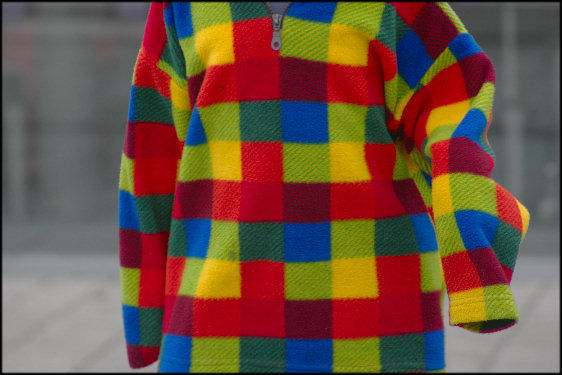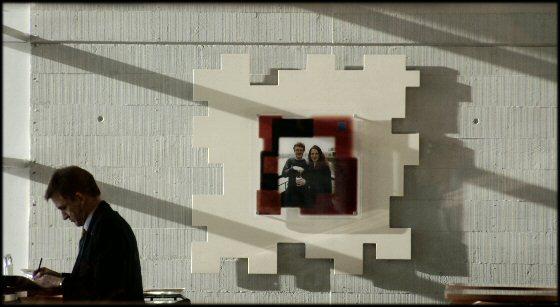 "Often I see links where there are none." says Thinking Through My Fingers' Jim Putnam. So do we all. Synchronicity has a strange effect on the mind. It's usually random, but deep seated atavistic species memory sees pattern and demands explanation. The result can often be a useful insight into something or other, down a path which would not otherwise have been explored, even though the trigger was spurious.
"Often I see links where there are none." says Thinking Through My Fingers' Jim Putnam. So do we all. Synchronicity has a strange effect on the mind. It's usually random, but deep seated atavistic species memory sees pattern and demands explanation. The result can often be a useful insight into something or other, down a path which would not otherwise have been explored, even though the trigger was spurious.
I had vague thoughts that perhaps I would write about my affection for the qualities of a particular camera lens. It was to be a deliberate attempt at tackling the recent desert in my self directed writing (to friends, to this blog, and several other outlets) after being ill for a time.
Then, as I lethargically shuffled thoughts and notes for the topic, I heard from a Canadian friend that he had bought a lens of the same type. That's the synchronicity bit.
On reflection the synchronicity was, on this occasion, neither meaningful nor random: I had brought it about myself. Steven had returned almost two weeks before from a trip "out west", and sent me a link to some of the resulting images which I had not acknowledged. As part of the same attempt to shake off post illness ennui, I stirred myself to belatedly tell him how much I had enjoyed them. Responding in his turn to my reply, he mentioned that for the trip west he had bought the new lens.
Enough about synchronicity, but now that I'm writing I'll keep going. So, back to my favourite lens.
 Back in the mists of time (circa 1960) when (aged eight) I was first bitten by the photography bug, a camera always came with a "standard lens". Most of my students, and many other people under 35 or so, have difficulty with this idea, but it underpinned the psychoperception of photographic seeing (for both the photographer and the viewer of their work) until quite recently. At age eight, and indeed up to age thirteen, that standard lens was also the only lens: it was built into the camera and could not be altered - nor did it zoom. At thirteen I acquired, with my first 35mm camera, an interchangeable lens mount - but I was sixteen before I gained any alternative lenses to go with it, and 20 before I tried out a zoom lens.
Back in the mists of time (circa 1960) when (aged eight) I was first bitten by the photography bug, a camera always came with a "standard lens". Most of my students, and many other people under 35 or so, have difficulty with this idea, but it underpinned the psychoperception of photographic seeing (for both the photographer and the viewer of their work) until quite recently. At age eight, and indeed up to age thirteen, that standard lens was also the only lens: it was built into the camera and could not be altered - nor did it zoom. At thirteen I acquired, with my first 35mm camera, an interchangeable lens mount - but I was sixteen before I gained any alternative lenses to go with it, and 20 before I tried out a zoom lens.
The definition of a "standard" lens was related to the normal field of view of human vision at rest. This is a commonsense idea which proves very difficult to pin down in practice, so a rule of thumb dictated that a standard lens should have a focal length roughly equal to the diagonal measurement of the negative produced by the camera. For a 35mm camera this should have been 43mm, but various practical engineering considerations led to 50mm being the norm in practice. (For most current digital SLRs, evolving in a world conditioned by 35mm experience but with image sensors smaller than 35mm, those would roughly translate to 28mm and 33mm respectively. But I'm not going to keep cluttering the text with these translations - if you are interested, you can refer to the conversion table which I posted here.)
 Like many who found themselves able to choose, I spurned the humble 50mm standard lens and cast it aside in favour of sexier new alternatives. Some people chose a new standard which in some way suited them better; others competed with each other in the number and variety of lenses they could lug about with them; and some, including most professionals, settled on a set of two or three (often mounted on different bodies) which fitted their needs. A common combination was a modest wide angle (often 35mm, sometimes 28mm) and an similarly modest telephoto (usually 135mm).
Like many who found themselves able to choose, I spurned the humble 50mm standard lens and cast it aside in favour of sexier new alternatives. Some people chose a new standard which in some way suited them better; others competed with each other in the number and variety of lenses they could lug about with them; and some, including most professionals, settled on a set of two or three (often mounted on different bodies) which fitted their needs. A common combination was a modest wide angle (often 35mm, sometimes 28mm) and an similarly modest telephoto (usually 135mm).
As a 16 year old Cartier Bresson wannabe, with a preference for studies of people's faces by available light in cafés and suchlike, I tended towards large apertures and focal lengths longer than the standard. I kept saving to ensure that new cameras came with standard lenses having the largest possible aperture: my first 35 mm camera, a Zorki 6 copy of Cartier Bresson's Leica with an f/3.5 standard lens was superseded by a Zenith which boasted f/2 and then a Pentax Spotmatic sporting a wide eyed f/1.4.
It was some time before I bought a wide angle lens: my first additions were 85mm and 135mm, also f/1.4, requiring even more babysitting hours to fund them than the camera itself. These became, or so I would have said, my new, self chosen, standard lenses. The 85mm (it gave an ideal perspective for portraiture) was my favourite standard lens where my subjects knew I was there, 135mm when they did not.
 When light was very low, however, I eventually had to admit that these two new friends had shortcomings. The problem was camera shake - the inability to hold a camera sufficiently steady to avoid blurring the image throughout the exposure time at low shutter speeds.
When light was very low, however, I eventually had to admit that these two new friends had shortcomings. The problem was camera shake - the inability to hold a camera sufficiently steady to avoid blurring the image throughout the exposure time at low shutter speeds.
I had chosen a Pentax camera rather than the more fashionable Canon or Nikon for several reasons, one of them being that the small and light Pentax body shape is easier to hold and operate in diverse circumstances. That makes it more feasible to hand hold a Pentax at low shutter speeds. The longer the lens, though, the less advantage this confers and the higher the minimum shutter speed has to be: the telephoto effect magnifies blur as well as the subject, while greater weight and bulk (espcially with large aperture designs) pulls at the hands. Even using the fastest films of the time, and push processing, I was regularly needing to use shutter speeds of 1/30 second or lower. With the 85mm I couldn't work reliably at shutter speeds of less than 1/60; with the 135mm, that rose to 1/125. With the lighter and smaller 50mm standard lens, though, I could hand hold down to a shutter speed of 1/15 second routinely, 1/8 or even 1/4 in favourable circumstances, and 1/2 if I was really lucky.
So, I found myself returning to the 50mm more and more, the other two being used less and less. And I gradually came to realise that I loved it not just for its ability to deliver in the light levels I required but for the particular combination of qualities it brought to the images which it formed. Some of these were easy to pin down; other less so; in total, though, taken together, there was a beautiful, rounded plasticity to the tonalities which it yielded. I was seduced by the sensuality which had been there, unappreciated, all along.
 I still have that lens, but time and technology have moved on; several generations of bayonet mount have replaced screw thread, mechanical linkages given way to electronic, and it now fits only the body (which I still have) on which it arrived. Luckily, though, Pentax seem to have left some crucial aspects of the optics alone throughout the years of change and refinement; successive generations of the lens have kept that sensuality, and it remains to a high degree in my current crop of FA series examples.
I still have that lens, but time and technology have moved on; several generations of bayonet mount have replaced screw thread, mechanical linkages given way to electronic, and it now fits only the body (which I still have) on which it arrived. Luckily, though, Pentax seem to have left some crucial aspects of the optics alone throughout the years of change and refinement; successive generations of the lens have kept that sensuality, and it remains to a high degree in my current crop of FA series examples.
Over the years, I've had other 50mm lenses. When working in hazardous circumstances where large apertures weren't essential, I used less expensive and more disposable f/1.8 or f/2, or even f/2.8, versions. For extreme low light conditions, there have been larger aperture lenses too - f/1.2 and even (on a Canon CRF body only slightly younger than I am) an astonishing f/0.7 light gatherer. Other focal lengths too, of course; the current inventory runs from 10mm to 1600mm, all of them valuable and valued, and the 21mm f/2.8 is amongst a small subset for which I have a particular fondness. On a digital body, of course, the 50mm lens behaves in some ways more as the 85mm did on film: the magnification and angle of view which it used to provide are now provided by the new 30mm (but still f/1.4) kid on the block. But first love wins out every time, and none of them can touch the lift of elated joy that I feel when I look through it.
 I do have a close second favourite. When I eventually bought a wide angle, it was a 24mm f/2 (half the focal length means half the blur from camera shake, so a one stop reduction in aperture gave the same hand held shutter speeds as the 50mm f/1.4). Its descendent, also a Pentax optic, has some (though not all) of the same quality. Steven didn't, I think, know that when he added to his notes on the new 50mm f/1.4 that so pleased is he with it that he is "planning to get a fast 24mm early in the year". He uses Canon equipment, not Pentax; but I hope he will be as lastingly happy with this pair as I have been with mine.
I do have a close second favourite. When I eventually bought a wide angle, it was a 24mm f/2 (half the focal length means half the blur from camera shake, so a one stop reduction in aperture gave the same hand held shutter speeds as the 50mm f/1.4). Its descendent, also a Pentax optic, has some (though not all) of the same quality. Steven didn't, I think, know that when he added to his notes on the new 50mm f/1.4 that so pleased is he with it that he is "planning to get a fast 24mm early in the year". He uses Canon equipment, not Pentax; but I hope he will be as lastingly happy with this pair as I have been with mine.
With that, an end to self indulgence. I'm writing again, which was the (selfish) point of the exercise. To anyone who stuck it out it this far: thank you, you've been a lovely audience ... good night.
No comments:
Post a Comment